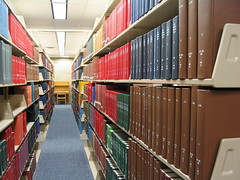[Professorial Lecture series post seven]
Networked technologies like the Internet and mobile devices connect people to both information and each other, fundamentally changing how we share and receive information. These connective technologies have enriched the information environment and has shaped our ability to navigate and interact with information flows, to develop and maintain new social networks, to create and share content, and to engage in customized and personalized ways.

20110604-NodeXL-Twitter-MobileMM11 graph (flickr.com/photos/marc_smith)
Just as the Internet has created new opportunities for libraries to provide innovative public services, emerging social communications tools changed the nature of scholarly dialog, who is sharing knowledge and how it is being communicated.
For scholar-librarians the social network provides a more open, transparent and participatory dialog by providing an opportunity for all librarians to make their voices heard and participate in the conversation. The social network allows scholars to communicate with each other internationally in real time, to target specific communities, access others’ research, and to attract more citations to their own works.
The social network has become a key tool for sharing and disseminating my ideas. Previously, as a scholar, if I wanted to communicate an idea or a research finding, my choices were limited to a journal article, a conference presentation, or a book or chapter. With the social network, I can write a blog post to get an immediate reaction to a concept that be worked into a conference presentation, shared through SlideShare and Twitter, and perhaps evolve into a paper that is submitted to a journal.
Conversely, I can reference not only other scholars publications, but their videos, presentations, blog posts, curated collections, and maybe even their social network. All of this combines to create a network that represents the modern scholar. I have also found that participating in the librarian-scholar social network has helped to build my internal academic identity more than my traditional publications.
Since communications on the social network are self-published and do not go through a pre-publication peer-review the dilemma of determining impact for tenure and promotion reviews remained. The available metrics included the number of time an item was viewed, how many times it was downloaded, or how many times it was embedded in another side are not perfect quality indicators but they do help to determine some level of impact.
Once again, a discussion around social media and other emerging technologies scholarship being explored by myself and Libraries colleagues was occurring, and again, had an impact. The University Libraries tenure and promotion criteria was changed in 2011 by the faculty body to acknowledge such works:
“No single type of publication/creative work is invariably a more significant component of a research program than another. Nevertheless, a body of work, which is cumulative in nature and reflects the highest academic standards, is required.”
 The professorial lecture provides an opportunity for faculty recently promoted to the rank of full professor to speak on a topic of their choosing. My professorial lecture, entitled “A Scholar’s Dilemmas” was held Thursday March 20, 2014 from 2:30-4:00 on the 11th floor of the Thompson Library on The Ohio State University Campus.
The professorial lecture provides an opportunity for faculty recently promoted to the rank of full professor to speak on a topic of their choosing. My professorial lecture, entitled “A Scholar’s Dilemmas” was held Thursday March 20, 2014 from 2:30-4:00 on the 11th floor of the Thompson Library on The Ohio State University Campus.





